
What Is Japanese Walking?
Japanese walking is a performance-forward approach to incline interval walking. Though not officially named in academic literature, it gained viral attention due to its structured format—alternating brisk and recovery-paced walking on an incline treadmill for about 30 minutes total.
The format echoes training methods used in Japan, where walking-based aerobic intervals have long been favored for developing cardiovascular fitness, especially among older adults. One landmark study, published in Mayo Clinic Proceedings in 2019, focused on incline interval walking and showed improvements in VO₂ max, leg strength, and systolic blood pressure in older participants3. The protocol? Alternating 3-minute fast walks with 3-minute recovery walks, four times a week.
Today, this method has evolved into a broader training tool adopted by athletes and forward-thinkers alike—ideal for those seeking structured, low-impact cardio with measurable returns.
What Makes It Different?
Unlike standard walking workouts or generalized interval walking, Japanese walking is:
- Deliberate: Repeats a 3:3 ratio of fast to slow walking
- Efficient: Lasts 30 minutes and fits within research-backed timeframes for cardiovascular adaptation3
- Challenging: Pushed further using treadmill incline benefits, precise pacing, and heart zone control
- Scalable: Easily adjusted for recovery, performance, or cross-training purposes
It’s essentially the clever person’s alternative to jogging, offering the benefits of fat burn walking, zone 2 training, and walking for longevity1, all while remaining low impact cardio.
Ways to Level Up Japanese Walking
1. Baseline Protocol: 30-Minute 3:3 Format
- Warm-up: 5 minutes at 0% incline, 2.5–3.0 mph
- Interval Set:
- 3 min fast walk at 4.0–4.5 mph and 10–12% incline
- 3 min recovery at 2.5–3.0 mph and 2–4% incline
- Repeat: 4–5x rounds
- Cool-down: 5 minutes at low incline and reduced pace
This is ideal for those looking to stay in aerobic threshold zones while building leg strength and aerobic capacity3.
Safety Reminder: Always maintain contact with the treadmill handles during incline segments. Never let go or lean forward. NordicTrack recommends wearing the safety key clipped to your clothing during use.
2. Strength & VO₂ Max Variation
Ideal for athletes cross-training or in a VO₂ development phase:
- Increase incline to 15% for fast segments
- Reduce recovery periods to 2 minutes
- Add resistance: wear a weighted vest or carry 1–2 lb dumbbells (only if safe to do so with handles)
This adaptation improves lower-body strength and cardiorespiratory output, targeting walking for VO₂ max3.
3. Performance Threshold Progression
For those focused on pushing pace without sacrificing form:
- Keep incline between 6–10%
- Increase fast segment pace to 5.0–5.5 mph
- Use an external heart rate monitor to stay in upper Zone 2 or low Zone 3 (2). If following an iFIT workout, ActivePulse™ can auto-adjust your incline and speed to keep you in your target zone.
4. Low-Impact Recovery or Taper Format
For rest days or post-race phases:
- 3:3 format using incline no higher than 5%
- Fast walk = 3.5 mph, slow walk = 2.5 mph
- Focus on nasal breathing, posture, and lateral stride alignment
Designed to facilitate active recovery without leaving the low impact cardio zone4.
5. “Over & Under” Hill Intervals
A twist on the standard format that adds neuromuscular variability:
- 2 min uphill fast walk at 12–15%
- 2 min downhill recovery at -3% to 0%
- Repeat for 6–8 rounds
This variation introduces motor control and neuromuscular coordination, preparing for variable outdoor terrains4.
6. Double Density Endurance Builder
For advanced users seeking durability and mental toughness:
- 2 cycles of 3:3 protocol, separated by a 2-minute active recovery
- Total time: 38–40 minutes
- Can be performed with alternating incline ramps: 6%–10%–12%–8%
This extended version supports mitochondrial adaptation and improved aerobic threshold2.
Japanese Walking vs. Traditional Interval Walking

Take the Challenge: Japanese Walking 14-Day Plan
| Day | Protocol Focus | Key Target |
| 1–3 | Baseline 3:3 | Adjust incline and pace |
| 4–6 | Strength Focus | Add weighted vest or increase incline |
| 7–10 | Threshold Push | Use HR data to refine pacing zones |
| 11–14 | Combo | Mix incline, density, and pacing for 30–40 minutes |
Track walking speed, incline tolerance, and recovery HR. Reassess VO₂ recovery or endurance at Day 142.
Explore More
- Take Your Walking to the Next Level with NordicTrack’s treadmill lineup:
- iFIT Features:
- SmartAdjust – let your treadmill learn and adapt to your pace
- ActivePulse – stay locked into your heart rate zone automatically
- AI Coach – get a truly personalized fitness plan built for your goals
- Suggested Next Steps:
- Explore iFIT’s immersive programs, from intermediate series to advanced challenges, designed to pair perfectly with Japanese Walking
- Learn how to master heart rate zones with ACE’s Zone 2 Training Guide (2)
FAQ
It’s a type of interval walking that alternates fast and recovery paces, often using incline for extra intensity3.
Yes. Studies show it boosts VO₂ max when done regularly as a structured 3:3 walking. protocol3.
It can be. The fixed intervals and incline treadmill workout offer greater cardiovascular benefits than step-count goals alone3.
Yes. It keeps your heart rate in the aerobic zone, making it ideal for zone 2 training and metabolic endurance2.
Absolutely. It adapts well for VO₂ max work, aerobic threshold building, and low impact cardio recovery2,4.
Use a treadmill with incline, supportive walking shoes, and always follow safety guidelines, especially with handrails and safety keys.
Yes, if you have hilly terrain. Treadmills give better control, but outdoor walking still supports aerobic threshold work3.
Add incline, increase fast pace, shorten recovery, or use resistance like a weighted vest, keeping safety in mind3.
References
- ACE Fitness. Understanding the 5 Heart Rate Zones. https://www.acefitness.org/resources/everyone/blog/8005/understanding-the-5-heart-rate-zones/
- Mayo Clinic. Walking: Trim Your Waistline, Improve Your Health.
https://www.mayoclinic.org/healthy-lifestyle/fitness/in-depth/walking/art-20046261 - Mayo Clinic Proceedings. Interval Walking Training Is More Effective Than Continuous Moderate-Intensity Walking for Improving Health Outcomes in Older Adults.
https://www.mayoclinicproceedings.org/article/S0025-6196(19)30473-2/abstract - National Institute on Aging. The Benefits of Exercise.
https://cehs.usu.edu/adrc/files/healthfair-handouts/Booth6-exercise-physical-activity-get-fit4-life-Optional.pdf
Disclaimer: The primary purpose of this blog post is to inform and entertain. Nothing on the post constitutes or is intended to be a substitute for professional medical advice, prevention, diagnosis, or treatment. Reliance on any information provided on the blog is solely at your own risk. Always seek the advice of your physician or other qualified health provider with any questions you may have regarding a medical condition, and please consult your doctor or other health care provider before making any changes to your diet, sleep methods, daily activity, or fitness routine. Do not disregard professional medical advice or delay seeking it because of information available on this blog. NordicTrack assumes no responsibility for any personal injury or damage sustained by any recommendations, opinions, or advice given in this article. Always follow the safety precautions included in the owner’s manual of your fitness equipment.


